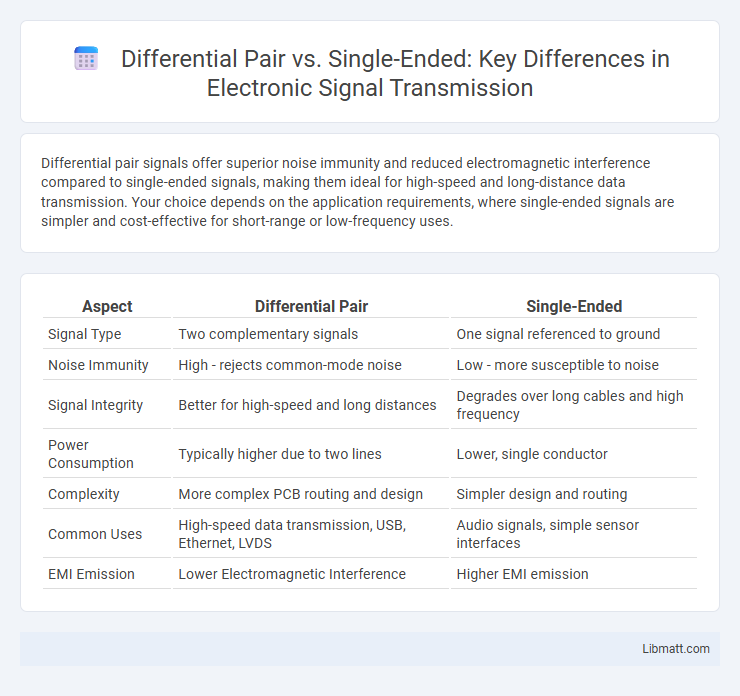Differential pair signals offer superior noise immunity and reduced electromagnetic interference compared to single-ended signals, making them ideal for high-speed and long-distance data transmission. Your choice depends on the application requirements, where single-ended signals are simpler and cost-effective for short-range or low-frequency uses.
Table of Comparison
| Aspect | Differential Pair | Single-Ended |
|---|---|---|
| Signal Type | Two complementary signals | One signal referenced to ground |
| Noise Immunity | High - rejects common-mode noise | Low - more susceptible to noise |
| Signal Integrity | Better for high-speed and long distances | Degrades over long cables and high frequency |
| Power Consumption | Typically higher due to two lines | Lower, single conductor |
| Complexity | More complex PCB routing and design | Simpler design and routing |
| Common Uses | High-speed data transmission, USB, Ethernet, LVDS | Audio signals, simple sensor interfaces |
| EMI Emission | Lower Electromagnetic Interference | Higher EMI emission |
Introduction to Differential Pair and Single-Ended Signaling
Differential pair signaling uses two complementary signals transmitted over two conductors, enhancing noise immunity and signal integrity by canceling out common-mode interference. Single-ended signaling transmits a single signal referenced to a common ground, making it simpler but more susceptible to noise and signal degradation. Differential pairs are preferred in high-speed data communication and sensitive analog circuits due to their superior noise rejection and reduced electromagnetic interference (EMI).
Key Concepts and Definitions
Differential pair signaling uses two complementary signals sent over paired conductors, allowing receivers to detect voltage differences and reject common-mode noise, which significantly improves signal integrity in high-speed communication. Single-ended signaling transmits one signal referenced to a common ground, making it more susceptible to electromagnetic interference and signal degradation over longer distances. Key concepts include differential voltage, common-mode noise rejection, impedance matching, and signal integrity, which are critical for designing reliable high-frequency circuits and communication systems.
Structure and Operation of Differential Pairs
Differential pairs consist of two complementary conductors carrying equal and opposite signals, enabling noise rejection through common-mode noise cancellation and improved signal integrity. Each line in the pair is tightly coupled and symmetrically routed to maintain impedance matching and minimize electromagnetic interference. In contrast, single-ended signals use a single conductor referenced to a common ground, making them more susceptible to noise and signal degradation over long distances.
Structure and Operation of Single-Ended Signaling
Single-ended signaling utilizes a single conductor to carry the signal voltage referenced to a common ground, making its structure simpler and more cost-effective compared to differential pairs. The signal is transmitted as a voltage difference between the single signal line and ground, which can be susceptible to noise and electromagnetic interference due to the lack of noise cancellation. Single-ended signaling is commonly used in low-speed, short-distance applications where signal integrity is less critical.
Signal Integrity Comparison
Differential pairs offer superior signal integrity compared to single-ended signals by minimizing electromagnetic interference and crosstalk through the use of two complementary signals that cancel out noise. The balanced nature of differential signaling reduces susceptibility to external noise sources and allows for higher data rates with lower error rates. Single-ended signals, relying on a single conductor referenced to ground, are more prone to signal degradation and distortion over longer distances or in noisy environments.
Noise Immunity and Electromagnetic Interference (EMI)
Differential pair signaling offers superior noise immunity by transmitting two complementary signals, enabling the receiver to reject common-mode noise and reduce electromagnetic interference (EMI) effectively. Single-ended signaling is more susceptible to noise and EMI because it relies on a single conductor referenced to ground, making it harder to distinguish signal from interference. Differential pairs also minimize EMI emissions due to the balanced currents in the conductors that generate opposing magnetic fields, resulting in lower radiated noise.
Cost and Complexity Differences
Differential pair signaling requires twice the number of conductors compared to single-ended, increasing material costs and PCB complexity. The routing demands precise impedance matching and tighter spacing, raising design difficulty and manufacturing expenses. Your choice impacts overall project budget due to these cost and complexity disparities.
Common Applications and Use Cases
Differential pairs are extensively used in high-speed data communication interfaces such as USB, HDMI, and Ethernet to minimize electromagnetic interference and improve signal integrity. Single-ended signaling remains common in low-speed or short-distance applications like audio signals, sensor outputs, and simple microcontroller connections due to its lower complexity and cost. Understanding the trade-offs between noise immunity and design complexity is crucial when selecting between differential pair and single-ended architectures in electronic systems.
Design Considerations in PCB Layout
Differential pair routing in PCB layout requires controlled impedance, matched trace lengths, and tight coupling to minimize electromagnetic interference and signal distortion, crucial for high-speed data transmission. Single-ended signals demand careful isolation from noise sources and proper ground referencing but are less complex in terms of length matching and impedance control. Your design choice impacts signal integrity, with differential pairs offering superior noise immunity and single-ended routing favoring simplicity and cost efficiency.
Conclusion: Choosing Between Differential Pair and Single-Ended
Choosing between differential pair and single-ended signaling depends on your system's noise immunity and signal integrity requirements. Differential pairs excel in minimizing electromagnetic interference and crosstalk, making them ideal for high-speed or noisy environments, while single-ended signals simplify design and reduce cost for low-frequency, short-distance applications. Evaluate your application's speed, distance, and environmental noise to determine the most effective signal transmission method.
Differential Pair vs Single-ended Infographic

 libmatt.com
libmatt.com